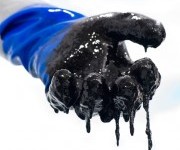 The routes of the existing and proposed Keystone pipelines. Image: RL MillerThe State Department is currently weighing whether to approve the Keystone XL pipeline, which would carry tar-sands oil some 2,000 miles southward, from Alberta, Canada, to Houston and Port Arthur, Texas. It would be an expansion of the now-operational Keystone pipeline that goes as far as Cushing, Okla. The original Keystone pipeline has been in operation less than one year, and its owner TransCanada predicts no more than one spill every seven years.
The routes of the existing and proposed Keystone pipelines. Image: RL MillerThe State Department is currently weighing whether to approve the Keystone XL pipeline, which would carry tar-sands oil some 2,000 miles southward, from Alberta, Canada, to Houston and Port Arthur, Texas. It would be an expansion of the now-operational Keystone pipeline that goes as far as Cushing, Okla. The original Keystone pipeline has been in operation less than one year, and its owner TransCanada predicts no more than one spill every seven years.
Instead of one spill every seven years, oil has spilled 11 times in the last year.
Whoops.
A May 7 spill of 500 barrels in North Dakota, which sent a geyser of oil spurting 60 feet into the air, was expected to shut the pipeline for a week. The spill apparently occurred as a result of a valve failure at a pumping station. TransCanada’s response: Spills at pumping stations don’t count toward the one-spill-every-seven-years estimate.
Oh, OK.
The Keystone pipelines carry diluted bitumen, a particularly thick, viscuous oil requiring up to 1,440 pounds per square inch (psi) pressure to move through a pipeline, according to a report [PDF] by the Natural Resources Defense Council. (The industry defines “high pressure” as anything above 600 psi.) The bitumen is particularly corrosive, and must be pumped at high temperatures that make it even more corrosive.
NRDC’s Anthony Swift tallies 11 leaks in 11 months, all at pumping stations:
- May 21, 2010
- June 23, 2010
- August 10, 2010
- August 19, 2010
- January 5, 2011
- January 31, 2011
- February 3, 2011
- February 23, 2011
- March 8, 2011
- March 16, 2011
- May 7, 2011
South Dakota blogger Cory Allen Heidelberger of Madville Times reviews TransCanada’s environmental impact statement and finds that South Dakota was hoodwinked. Heidelberger quotes a June 2006 pipeline risk assessment [PDF], part of TransCanada’s permit application in the state, which predicts the following spill frquencies:
Of the postulated 1.4 spills along the Keystone Pipeline system during a 10-year period, the study’s findings suggest that approximately 0.2 would be 50 barrels or less; 0.8 would consist of 50 to 1000 barrels; 0.3 would consist of between 1,000 and 10,000 barrels; and 0.2 would contain more than 10,000 barrels … Based on probabilities generated from the study, the estimated occurrence intervals for a spill of 50 barrels or less occurring anywhere along the entire pipeline system is once every 65 years, a spill between 50 and 1,000 barrels might occur once in 12 years; a spill of 1,000 and 10,000 barrels might occur once in 39 years; and a spill containing more than 10,000 barrels might occur once in 50 years.
Does TransCanada seriously believe it can absolve itself by claiming that spills at pumping stations don’t count as risk within its pipeline system?
Keystone’s tar-sands oil is not good for Canada, the United States, or the planet. Keystone XL will greatly expand the capacity of the original Keystone pipeline. It will also cross a number of sensitive habitats, including those favored by whooping cranes (Nebraska) and pronghorn antelopes (Montana). Most alarming, perhaps, the pipeline will cross a large portion of the Ogallala Aquifer in Nebraska.
The original pipeline is demonstrably leak-prone. So why on earth would the State Department supersize this disaster?


